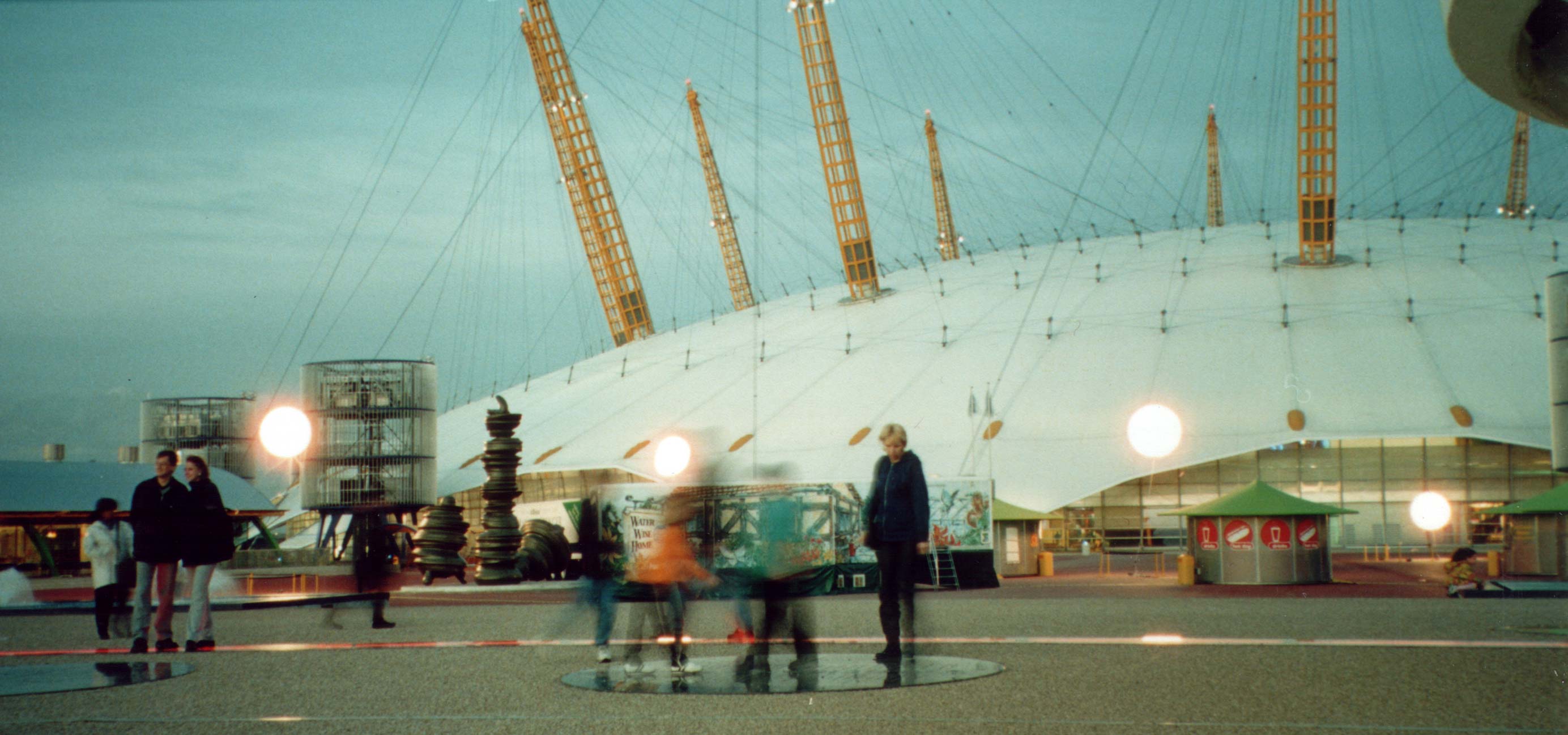PTFE

|
| The Millennium Dome, London, comprises a double-layer PTFE-coated glass-fabric membrane. |
Contents |
[edit] Introduction
Polytetrafluoroethylene (PTFE) is a thermoplastic compound noted for its very significant chemical inertness and heat resistance. Commonly encountered as a non-stick coating for pots and pans it is sometimes referred to by the trade name ‘Teflon’ or 'Syncolon'. It is widely used for a variety of engineering and chemical applications.
[edit] Properties of PTFE
PTFE is a synthetic fluoropolymer of tetrafluoroethylene discovered accidentally by Dr Roy Plunkett in 1938 while working for DuPont in the US. With a high molecular weight, it consists entirely of carbon and fluorine. Displaying reduced stress cracking and corrosion, it is also hydrophobic, which means it cannot be wetted by water or water-containing liquids. It also displays one of the lowest coefficients of friction of any solid so that even geckos and insects cannot crawl up it.
Its properties include:
- Very low friction coefficient.
- Resists corrosion.
- Significantly chemically inert.
- Withstands wide temperature ranges.
- Good abrasion resistance.
- Non-porous.
[edit] Uses in construction
Generally in construction and infrastructure, PTFE’s main applications are for providing friction-control performance wherever components move in relation to one another e.g in the fabrication and erection of steelwork to minimise the stresses produced by the imperfect alignment of steel members; for expansion joints, slide bearings, on bridge bearings and dams, gaskets and electrical insulation; also, as an insulator to prevent thermal bridging e.g where a pipe passes through an external wall.
As a lubricant, it reduces friction, wear and energy consumption (in machinery). This was exploited skilfully on the construction of the Millau Viaduct in southern France: PTFE-coated bearings were used to reduce the huge friction generated as the road deck was slid into place over the supporting pylons.
In 1972, PTFE-coated glass fabrics were introduced following their development by NASA for the manufacture of space suits. The Millennium Dome in London, comprises a double-layer PTFE-coated glass fabric membrane.
PTFE-coated glass is expensive but tends to have a longer life than PVC coated polyester, it is also stronger, adn self-cleaning. The first application of PTFE-coated glass was in the La Verne College Student Centre, in California (1973). In 1993, twenty years later, the original membrane was still in place, and was still capable of withstanding around 75% of its original design load.
Other developments have included woven PTFE fibre (hydrophobic, microporous, and extremely durable) for tensile structures.
For more information see: Fabric structures.
Wiring in aerospace and computer applications consumes about 50% of PTFE production, particularly as an insulator in connectors and cables. Other uses include gears, seals, gaskets and bushings, lining hose assemblies, windscreen wiper blades, industrial pipe lines, and as a waterproof coating for outdoor clothing.
PTFE is closely related to ETFE (ethylene-tetra-fluoro-ethylene) which comprises modified copolymers of ethylene and tetrafluoroethylene. It has many similar properties to PTFE and in recent years has been widely used in construction.
[edit] Related articles on Designing Buildings Wiki
- Acrylic.
- Architectural fabrics.
- Carbon fibre.
- Composites.
- ETFE.
- Fabric structures.
- Millennium Dome.
- Nylon.
- Plastic.
- Polycarbonate plastic.
- Polyethylene.
- Tensile structures.
- The history of fabric structures.
- The development of structural membranes.
- The Millau Viaduct.
- The structural behaviour of architectural fabric structures.
- The thermal behaviour of spaces enclosed by fabric membranes.
- Transparent insulation materials.
Featured articles and news
The UK's Modern Industrial Strategy: A 10 year plan
Previous consultation criticism, current key elements and general support with some persisting reservations.
Building Safety Regulator reforms
New roles, new staff and a new fast track service pave the way for a single construction regulator.
Architectural Technologist CPDs and Communications
CIAT CPD… and how you can do it!
Cooling centres and cool spaces
Managing extreme heat in cities by directing the public to places for heat stress relief and water sources.
Winter gardens: A brief history and warm variations
Extending the season with glass in different forms and terms.
Restoring Great Yarmouth's Winter Gardens
Transforming one of the least sustainable constructions imaginable.
Construction Skills Mission Board launch sector drive
Newly formed government and industry collaboration set strategy for recruiting an additional 100,000 construction workers a year.
New Architects Code comes into effect in September 2025
ARB Architects Code of Conduct and Practice available with ongoing consultation regarding guidance.
Welsh Skills Body (Medr) launches ambitious plan
The new skills body brings together funding and regulation of tertiary education and research for the devolved nation.
Paul Gandy FCIOB announced as next CIOB President
Former Tilbury Douglas CEO takes helm.
UK Infrastructure: A 10 Year Strategy. In brief with reactions
With the National Infrastructure and Service Transformation Authority (NISTA).
Ebenezer Howard: inventor of the garden city. Book review.
The Grenfell Tower fire, eight years on
A time to pause and reflect as Dubai tower block fire reported just before anniversary.
Airtightness Topic Guide BSRIA TG 27/2025
Explaining the basics of airtightness, what it is, why it's important, when it's required and how it's carried out.
Construction contract awards hit lowest point of 2025
Plummeting for second consecutive month, intensifying concerns for housing and infrastructure goals.
Understanding Mental Health in the Built Environment 2025
Examining the state of mental health in construction, shedding light on levels of stress, anxiety and depression.





















